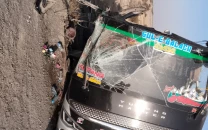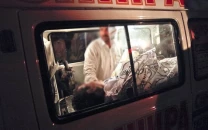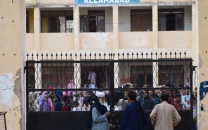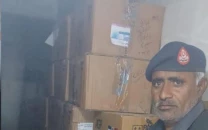In Balochistan, 28% children still out of school
Survey says 39% govt primary schools have boundary walls as compared to 91% of private schools

PHOTO: AFP
These findings were made public in a report of annual citizen-led household based ASER Survey 2018. The eighth ASER Survey Balochistan report was launched in Quetta on Wednesday.
ASER has historically tracked early childhood education (ECE). In 2014, the ECE enrollment was recorded at 28% to be declined to 22% in 2015 and 2016. This enrolment rate once again rose to 28% in 2018 in rural Balochistan.
Learning in ASER 2018 reveals declining trends in student competencies in language. 40% class 5 children could read a class 2 level story in Urdu compared to 42% in 2016. In English, 34% class 5 children could read class 2 level sentences compared to 38% in 2016.
The survey highlights that children enrolled in private schools are performing better compared to those studying in government schools. 46% children enrolled in class 5 in private schools were able to read a story in Urdu compared to 40% class 5 students studying at government schools.
The difference in learning levels for English are also the same as Urdu where 51% private school’s class 5 could read English class 2 level sentences compared to 34% public sector students.
This year, the percentage of mothers having completed primary education has gone up (12%) as compared to 2016 (10%). In addition to the assessment of children, the report also highlights school functioning across every district in Balochistan.
The ASER rural Balochistan survey says overall teachers’ attendance in government schools stood at 93% as compared to 96% in private schools on the day of the survey.
Private school teachers were reported to have better qualifications at graduate levels – 45% teachers in private schools are graduates compared to 32% in government schools.
However, for MA, MSC or post graduate qualifications, larger percentage of public sector teachers have a higher qualification than private sector counterparts. The trends in multi-grade teaching across schools are also mixed.
ASER 2018 Balochistan rural findings have found 56% of government and 5% of private schools imparting multi-grade teaching at class 2 level; whilst at the class 8 level, multi-grade teaching is more prevalent in the private sector as compared to government schools.
Some 39% government primary schools had boundary walls as compared to 91% of private primary schools. With regard to availability of functional toilets, overall the facility was available in 11% public and 100% private primary schools in rural Balochistan.
Some 31% of all surveyed government primary schools in Balochistan while 96% of all surveyed private primary schools in Balochistan had useable water facility.
The funds/grants received by the government schools have decline as compared to 2016 – 2% primary, 3% middle and 3% high schools received grants in 2018, compared to 6%, 11%, and 19% in 2016 respectively.



















COMMENTS
Comments are moderated and generally will be posted if they are on-topic and not abusive.
For more information, please see our Comments FAQ